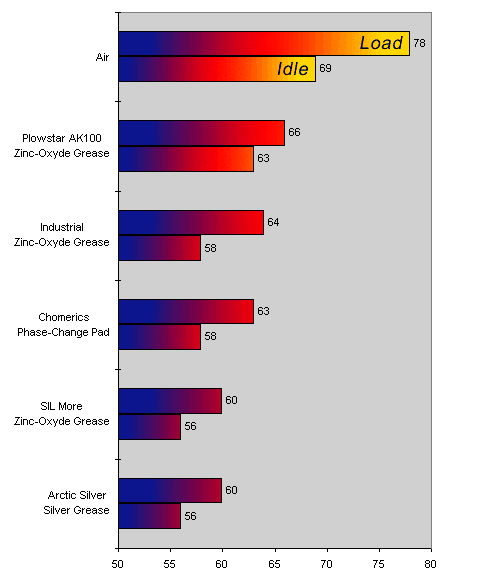last change: 07.08.2001
since 16.9.2000

Why the heck is there a tank ?!?
Main Page
"HowTo" Guides
Troubleshooting Guides
BIOS related information
CPU related information
Overclocking
Articles
Downloads
Forum
Contact
Links
|
What heat transfer material is best ?
|
|
Have you ever wondered which material to put between your CPU and Cooler ?
Well, here's how different interface materials rate. The test setup was the same as during the cooler test. To maximize the stress on the interface material, a very good heatsink was used, the Dynatron DC1206BM-O. The thermal greases used were different brands of either zinc-oxyde / silicone based or silver based grease (Artic Silver II in this case). For the family of phase change heat transfer pads, a chomerics
pad was used. Whenever you see a pink pad, chances are good this
is a chomerics pad. Other manufacturers are Bergquist (black) or
Dow Corning (black). "Phase Change" refers to the behaviour of these pads. While their consistence is gooey at room temperature, they get liquid if heated over a certain limit (somewhere over 50°C). In general, these heat transfer pads are not inferior to generic zinc-oxyde greases in terms of performance. To the contrary, according to experts they keep stable for a longer time than grease. The downside of using these pads is, however, that they can be used only one time. After that they have to be carefully removed and a new one has to be applied. A few tips for removing heat transfer materials, as this was frequently asked in the forum : Grease Chomerics Pads (Pink) Other Pads (Black) Now for the results :
Not much surprise is that with no heat transfer material used (Air) even the best cooler has a hard time to get the CPU down to a reasonable temperature. A little more surprising is that the "standard" white zinc-oxyde thermal grease can be of quite different qualities. I know of only few shops which will tell you what brand of grease you buy, so there's some luck involved if you get a good or not so good grease. On the other end of the scale is silver based grease. This is a lot more expensive than the simple white grease, but, as the results show, has very good heat conduction characteristics. Wether the different brands of silver based grease are of different qualities, too, has still to be tested ... |
